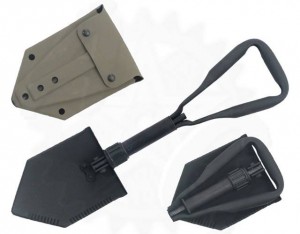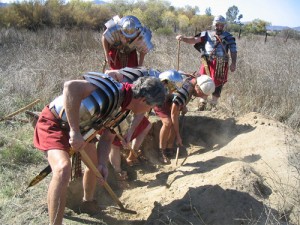Here is another tool that I have a love hate relationship with. While it is amazingly compact, it sucks for digging anything larger than a personal foxhole. No matter what era, if you get a real MILSPEC item you will be pleased with both its durability and quality. I’ll hit history over the next few paragraphs but here are some things to look for when you purchase an E-Tool, as there are many fakes that will buckle and break on you, or I’ve seen some where the screw device near the spade will not hold fast. From Gazerstar’s eBay U.S. Entrenching Tool Identification — Spot a Fake!:
1. Fakes are not normally marked with MILSPEC markings [“U.S,” and many models: maker’s name and date].
2. Fakes are generally manufactured with shortcuts: softer wooden handles; cheap steel stamped/flat blades; shorter hilts in the folding varieties; bolted instead of riveted; and shorder handles.
3. Fakes may be found covered with a MILSPEC carrier or vice versa.
4. Some very smart folks also produce “Reproductions,” which might be modern versions of MILSPEC, or might be good looking, but non-functional investments…
5. Fakes have been around at least 50 years in some cases. Just because a shovel was bought at the Estate Sale of a former veteran doesn’t necessarily mean it was a genuine MILSPEC Entrenching Tool…
Entrenching tools go back at least to the times of the Roman Legion. Julius Caesar, as well as other ancient writers, documented the use of spades and other digging implements as important tools of war. The Roman Legion when on the march dug a ditch and rampart around their camps every night where established camps were not available, and we thought foxholes and machinegun positions blew.
During the 20th century, the ancestor of the modern entrenching tool appeared in the form of the handled entrenching shovel or spade, designed to be used with both hands, yet more compact than traditional, full-sized engineer shovels or spades. These tools became extremely important with the introduction of trench warfare. Entrenching tools designed for the individual infantryman soon appeared with short straight handles, T-handles, D-handles, and other designs.
During World War I, the entrenching spade was also pressed into service as a weapon. In the close confines of a trench, rifles and fixed bayonets were often too long for effective use, and entrenching tools were often used as auxiliary arms for close-quarter fighting.
After World War I, entrenching tools were again redesigned to be more compact and lighter in weight. Folding designs became increasingly popular, usually incorporating a fixed handle with a folding shovel head, and sometimes encompassing a pick into the design. Like all individual entrenching tools, they were designed to be easily carried as part of an infantry soldier’s standard pack equipment.
The United States Army folding spade, or entrenching tool, has evolved from a single fold spade with a straight handle; to a tri-fold design with a modified “D” handle design with all steel construction, to a similar light weight plastic and steel tri-fold design adopted by NATO as the standard issue entrenching tool. Other folding variants have also been issued. The latest light weight plastic tri-fold design is thirty percent lighter than the all-steel tri-fold was: 1.5 pounds (0.68 kg) instead of 2.25 pounds (1.02 kg).
Entrenching tools, if strongly built, can also be used as weapons. Some entrenching tools can be even sharpened on one or both sides of the blade to be used as cutting tools or weapons; in fact, when used as such, the tool’s sharp, thick edges are strong enough to cut through flesh and bone. During the Second World War, entrenchment spades were used in close quarters combat between German and Soviet forces. Soviet Spetsnaz units were well trained in the use of the standard short-handled Russian entrenching shovel (“saperka”) as a weapon; by the nature of their missions, such tools were only rarely used for digging or entrenching positions. Modern commando forces, too, are trained to fight with entrenchment tools.
Many millions of surplus entrenching tools have made their way into the hands of civilians. They are commonly used for camping, gardening and by war re-enactment groups. Some people collect the older issue entrenching tools as military memorabilia.
I carry one of these beauties in my bug-out-bag because it has always proved such a useful implement; and in the case of zombies the serrated edge will do wonders in lobbing off head, or it can be configured as a pick axe for massive brain trauma.
Jon




Leave a Reply